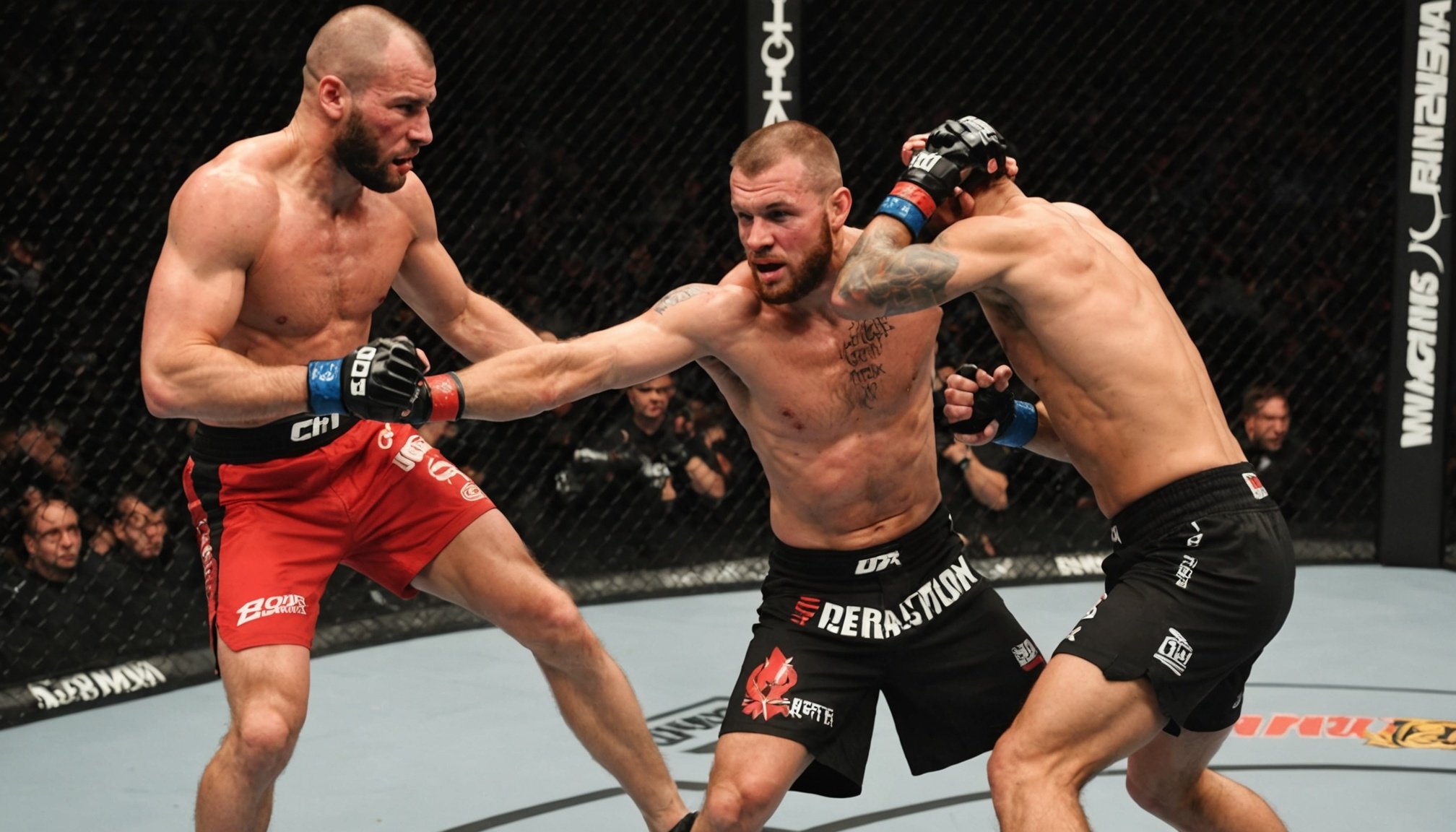Mastering Adrenaline Management: Top Strategies for UK MMA Fighters
Managing adrenaline is a crucial aspect of success in Mixed Martial Arts (MMA), particularly for fighters in the UK who compete at the highest levels. Here, we will delve into the top strategies that UK MMA fighters can employ to master adrenaline management, enhancing their performance and mental toughness in the ring.
Understanding Adrenaline in Combat Sports
Adrenaline, often associated with the ‘fight or flight’ response, is a hormone released by the adrenal glands in response to stress. In combat sports like MMA, boxing, and Muay Thai, managing this response is vital for optimal performance.
Also read : How can athletes set realistic goals to measure their progress in combat sports?
The Role of Adrenaline
Adrenaline increases heart rate, blood pressure, and energy levels, preparing the body for intense physical activity. However, if not managed properly, it can lead to anxiety, decreased focus, and poor decision-making during a fight.
Real-Life Example
Consider the experience of a seasoned MMA fighter preparing for a major bout. The pre-fight anxiety can be overwhelming, but by using specific techniques, the fighter can channel this adrenaline into focused energy rather than debilitating anxiety.
Also to see : How can fighters develop their own unique fighting style while training?
Breathing Techniques for Adrenaline Management
Breathing is one of the most effective ways to manage adrenaline and maintain a calm, focused state.
Diaphragmatic Breathing
Diaphragmatic breathing, also known as “belly breathing,” is a technique that engages the parasympathetic nervous system, counteracting the fight-or-flight response. By filling the abdomen with deep, calm breaths, fighters can lower their heart rate and relax tense muscles.
Boxer’s Breath
The “Boxer’s Breath” involves short, rapid inhalations followed by extended exhalations. This pattern helps increase oxygen intake and stamina during rounds, while also maintaining mental clarity and focus.
Mental Techniques for Enhanced Performance
Mental preparation is as crucial as physical training in combat sports.
Visualization
Visualization involves creating clear mental pictures of desired outcomes. Fighters can practice successful punches, combos, and defensive moves in their minds, improving accuracy and muscle memory. This technique also helps in managing pre-fight anxiety by visualizing oneself staying composed and focused during the fight.
Psychosomatic Training
Developed by Daniel Domaradzki, psychosomatic training helps bridge the gap between the autonomic nervous system and the conscious mind. Fighters can use targeted mental exercises to control physiological reactions like heart rate, muscle tension, and pain perception. By mentally practicing situations and linking them to desired physiological results, fighters can train their bodies to respond to stress more effectively.
Genetic and Epigenetic Factors
While mental and breathing techniques are essential, understanding the genetic and epigenetic factors influencing dopamine and athletic performance can provide additional insights.
Dopamine and Athletic Success
Dopamine plays a significant role in motivation, pleasure, and reward. Research indicates that dopamine-related genetic polymorphisms can influence athletic success. For instance, certain dopamine receptor genes can affect personality traits and cognitive functions that are crucial for athletic performance.
Practical Applications
Understanding these genetic and epigenetic factors can help in tailoring training programs. For example, knowing how dopamine affects motivation can help coaches design more effective motivational strategies for their fighters.
Strength Training and Physical Conditioning
Physical conditioning is a cornerstone of any combat sports training program.
High-Intensity Training
High-intensity interval training (HIIT) is particularly effective for MMA fighters. This type of training mimics the intense bursts of energy required during a fight, improving cardiovascular endurance and muscular strength. Incorporating strength training, such as weightlifting and bodyweight exercises, enhances overall physical performance and resilience.
Thai Training and Muay Thai
Muay Thai, known for its intense physical demands, includes techniques like knee strikes and clinching. Incorporating Muay Thai into a training regimen can improve cardiovascular fitness, muscular endurance, and overall combat readiness. Thai training also emphasizes mental toughness and discipline, which are essential for managing adrenaline during fights.
Managing Stress and Anxiety
Stress and anxiety are inevitable components of competitive combat sports.
Mindfulness and Meditation
Mindfulness exercises, such as meditation, help fighters develop mental resilience. By practicing mindfulness, fighters can recognize and accept challenging emotions without becoming overwhelmed. This mental toughness aids in preserving concentration and poise during high-stress competitions.
Pre-Fight Preparation
Pre-fight preparation is critical for managing stress and anxiety. Techniques like box breathing and diaphragmatic breathing, when practiced regularly, can help control the autonomic nervous system, reducing the negative physiological impacts of stress. Visualization and psychosomatic training also play key roles in pre-fight mental preparation.
Practical Insights and Actionable Advice
Here are some practical tips and insights for UK MMA fighters to master adrenaline management:
Breathing Exercises
- Diaphragmatic Breathing: Practice deep, belly breathing to calm the nervous system.
- Boxer’s Breath: Use short, rapid inhalations followed by extended exhalations to increase oxygen intake and stamina.
Mental Preparation
- Visualization: Visualize successful outcomes and different combat scenarios to boost confidence and reduce anxiety.
- Psychosomatic Training: Use targeted mental exercises to control physiological reactions and improve resilience.
Physical Conditioning
- High-Intensity Training: Incorporate HIIT to improve cardiovascular endurance and muscular strength.
- Muay Thai and Strength Training: Include Muay Thai and strength training to enhance overall physical performance and combat readiness.
Stress Management
- Mindfulness and Meditation: Practice mindfulness exercises to develop mental resilience and manage stress.
- Pre-Fight Preparation: Regularly practice breathing techniques, visualization, and psychosomatic training as part of pre-fight preparation.
Table: Comparison of Breathing Techniques
| Technique | Description | Benefits |
|---|---|---|
| Diaphragmatic Breathing | Engages the parasympathetic nervous system, using deep belly breaths. | Lowers heart rate, relaxes muscles, reduces stress. |
| Boxer’s Breath | Short, rapid inhalations followed by extended exhalations. | Increases oxygen intake, improves stamina, maintains mental clarity. |
| Progressive Muscle Relaxation | Tenses and relaxes different muscle groups. | Reduces muscle tension, improves focus, enhances relaxation. |
Quotes from Experts
- “By incorporating breathwork into their routine, fighters can develop a heightened awareness of their internal state and gain mastery over their physiological responses, transforming anxiety into focused energy within the ring.” – [FightBook MMA]
- “Dopamine plays a significant role in motivation, pleasure, and reward. Understanding dopamine-related genetic polymorphisms can help in tailoring training programs to enhance athletic performance.” – [MDPI]
Mastering adrenaline management is a multifaceted process that involves breathing techniques, mental preparation, physical conditioning, and stress management. By integrating these strategies into their training regimen, UK MMA fighters can enhance their performance, mental toughness, and overall success in the ring.
Whether through diaphragmatic breathing, visualization, or high-intensity training, each technique contributes to a fighter’s ability to manage adrenaline effectively. Understanding genetic and epigenetic factors can further tailor these strategies to individual needs. As the sport continues to evolve, mastering adrenaline management will remain a key differentiator between champions and contenders.











